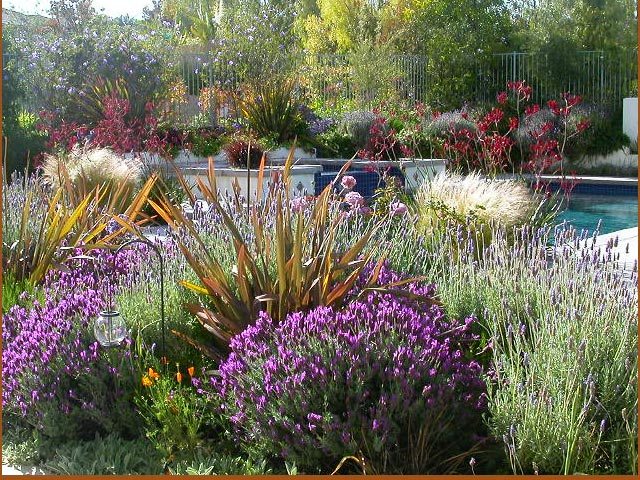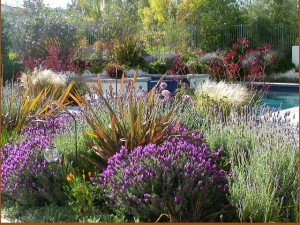Drought-Resistant Gardening

 Question: I heard you speak at the Fallbrook Garden Club. I ordered your most current book tonight. Which of your books (or is there a book that isn’t yours that you recommend?) would have the most information on drought-resistant plants for us in Fallbrook who don’t have much water? I assume succulents and cacti are what I need. But I am new here and need specific recommendations. Thanks for your help.
Question: I heard you speak at the Fallbrook Garden Club. I ordered your most current book tonight. Which of your books (or is there a book that isn’t yours that you recommend?) would have the most information on drought-resistant plants for us in Fallbrook who don’t have much water? I assume succulents and cacti are what I need. But I am new here and need specific recommendations. Thanks for your help.
Answer: I’m so glad you ordered my book. It covers all the plants we grow in handy month-by-month format but emphasizes drought-resistant gardening and plants throughout. Additionally, there are sections on native plants, the latest information on how to grow them, a new section on planting a desert garden —”Making a Garden is Like Baking a Cake”—, an updated succulent and cacti section, and a whole new section on fire-resistant gardening which especially impacts those living near wild areas. And it helps long time gardeners as well as new residents who soon find out how different gardening is here than anywhere else where they may have lived. I can’t count the times that people have told me they moved here from somewhere else, this book helped them from the get-go, and it is now their “gardening bible.”
Since you are new to gardening in Southern California, I also want to emphasize that a garden of succulents is not the only way to go. Succulents are just one large group of drought-resistant plants of many genuses that store water in their structural parts, such as leaves, branches, and trunks. Succulents can be stunning when planted in a well-designed arrangement, and yes, you could plant a whole drought-resistant garden of them as many gardeners have successfully done. However, you don’t have to carpet the ground with gravel and resort to nothing but prickly cacti or poisonous euphorbias in order to have a water-thrifty garden. You can plant a succulent garden that contains no euphorbias or cacti and still have a fascinatingly varied landscape. You could also plant a completely drought-resistant garden that does not contain a single succulent or cactus.
Take California native plants, for example, though a few of them are succulent plants most are not. During the last fifty years, while gardeners largely ignored native plants or brushed them aside as “difficult”, botanical gardens, hybridizers, and native plant enthusiasts came up with a whole raft of new, easy-to-grow selections and varieties and some of these need no summer water at all. Now that gardeners have at last become serious about saving water, they suddenly find that —Viola!—they have a whole plethora of wonderful species to plant that are much easier than those available years ago. Also, now there are several fine nurseries, such as Tree of Life Nursery near San Juan Capistrano, that specialize exclusively in native plants and are great fun to visit. (See Tree of Life website for hours and days open.)
In addition to native plants, many. but not all, grasses, palms, flowering subtropical trees, shrubs, and climbers—wisteria is a perfect example—, perennials, annuals, bulbs, shrubs, and even one rose are drought resistant. Lady Banks rose has no thorns, no diseases, and no pests and once established is highly drought-resistant. The largest rose in the world is a Lady Banks (Rosa banksiae ‘Lutea’) surviving for over a century in Tombstone Arizona without irrigation.
That said, among other books I especially recommend are Debra Baldwin’s “Designing with Succulents” and her new book “Succulent Container Gardens.” Another book that would help you is one I wrote called “The American Horticultural Society Southwest SMART GARDEN™ Regional Guide“. On pages 82 and 83 you will find a list of all the lists inside the book. Each page contains as many as 6 photographs of the plants on that particular list. Many but not all lists pertain to drought-resistant plants and they are arranged according to how you would use them. The book contains 8 pages on succulents alone: 2 pages each of succulent perennials, succulent shrubs, succulent climbers, and succulent trees. This book will teach you to recognize many of the plants that grow here but it will also help you choose good drought-resistant ones for your garden.
Every local gardener should own a copy of “Sunset Western Garden Book” and refer to the illustrated lists on drought-resistant plants in the beginning of the book. You can also identify which Sunset Climate Zone you are living in by referring to the opening pages of this book. Other wonderful books are: “California Native Plants for the Garden” by Bornstein, Fross, and O’Brien, “Native Landscaping from El Paso to L.A.” by Sally Waskowski with Andy Wasowski, and “Plants and Landscapes for Summer-Dry Climates of the San Francisco Bay Region” by the East Bay Municipal Utility District. All these books are chock full of wonderful photographs.


My husband and I live in the western end of the San Fernando Valley, in Sunset Zone 19. We’re in the process of removing our traditional lawn. I’ve done some research and have come up with what I believe would be viable drought-tolerant alternatives: microclover, yarrow and sheep’s fescue. We have both full sun and shade (due to mature trees), so whatever we plant needs to do well in both. We have clay-like soil, but plan to amend with lots of compost. We also have dogs, so whatever we plant can’t be too fragile. What are your thoughts? I’m also open to other suggestions.
First, I recommend two books: Reimagining the California Lawn: Water-conserving Plants, Practices, and Designs by Carol Bornstein, David Fross, and Bart O’Brien and Life After Lawns: 8 steps from Grass to A Waterwise Garden, by Molly Bogh and Bill Schnetz. You can order these at Amazon.com. Of the choices you offer I think microclover will require too much irrigation in sun, but might work in your shady areas, sheep’s fescue is tough and worth a try if you get the right variety—new varieties are being studied for lawn use—, and common yarrow is the best of the three but takes time to spread. Running dogs can slow this process but dogs usually don’t kill the yarrow except when they dig for gophers. The one you want is Achillea millefolium. Buy it in big sacks and plant it in fall, sprinkle when rains are inadequate. Eventually it makes a mowable lawn. My experience is that it won’t grow in shade. A nice way to go is to plant other yarrow species and varieties in with it and let them fight it out and grow together. The flowers are lovely and you can simply mow with a weed-wacker when they fade. A good idea is to make a lawn that is more like a flowering meadow with many different kinds of bulbs, grasses and sedges, yarrows, etc and see what works. David Fross has made several areas like this in his central California nursery. Have you see the “Living roof” in San Francisco at the California Academy of Sciences in Golden Gate Park? Seeing this gave me inspiration for trying to establish a similar lawn-like mix of flowering plants on my terraces in my own garden. Also, I’ve found that yarrow (Achillea) has been temporarily crowded out in my garden by Mexican evening primrose (Oenothera speciosa), which has taken over an entire walled terrace in my lower garden.—This plant arrived in a mixed seed packet of wildflowers even though it was not mentioned on the label as one of the ingredients.—For three of four years I tried to pull it out with help from various hired garden helpers, friends and family, but did not succeed. So last fall, by which time it had spread into a large clump and a few other areas on the terrace, I asked my once-a-week gardener, Raymundo, who has worked for me for 59 years and speaks English, to dig it all out along with the roots. I made motions like digging with a spade and asked him please not to pull out the South African bulbs growing all over the terrace, but if they came out along with the primroses, to save them for me. I then went out for the day satisfied that he is very good at this kind of job and I would finally be rid of them. It was September and I planned to amend the soil and replant with my own wildflower mix in November. When I came home that night I found Raymundo had pulled out and thrown away all the South African bulbs and saved all the primroses. I laughed and gave up. Now, the day after Easter in 2015, I think Raymundo did me a great favor as long as the primrose stays put on that one terrace. After I saw what he had done I pulled out or cut off the tall ones, and during the winter this one patch of Mexican evening primroses spread like a green mat all over the terrace and was like a green lawn all winter needing little or no irrigation. Yesterday when I had 25 family for Easter breakfast and egg hunt, plus a few drop-in friends in my garden, this terrace was solid flowers. Nothing kills it and you can walk on it as I did all winter and my 6 great grandchildren (I have 8 total of these delightful beings) were all over it yesterday. Your dogs could run on it and never kill it. Nothing kills it. However, do not plant this unless you want it everywhere. It will completely take over. Also I am in a coastal zone, but this plant does well inland or in Arizona and is made for a dry climate. Another possible plant for you is Lippea (Phyla nodiflora), but you would need to mow off the flowers in June or your dogs will step on bees when it flowers. It works as a lawn or perhaps one ingredient in a mixed lawn since in your climate zone it will need some water.